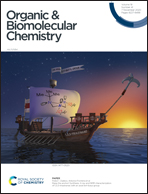Systematic synthesis of novel phosphoglycolipid analogues as potential agonists of GPR55†
Abstract
Rhodopsin-like G protein-coupled receptor (GPCR) GPR55 is attracting attention as a pharmaceutical target, because of its relationship with various physiological and pathological events. Although GPR55 was initially deorphanized as a cannabinoid receptor, lysophosphatidylinositol (LPI) is now widely perceived to be an endogenous ligand of GPR55. Recently, lysophosphatidyl-β-D-glucoside (LPGlc) has been found to act on GPR55 to repel dorsal root ganglion (DRG) neurons. In this study, we designed and synthesized various LPGlc analogues having the squaryldiamide group as potential agonists of GPR55. By the axon turning assay, several analogues exhibited similar activities to that of LPGlc. These results will provide valuable information for understanding the mode of action of LPGlc and its analogues and for the discovery of potent and selective antagonists or agonists of GPR55.

- This article is part of the themed collection: Chemical Biology in OBC


 Please wait while we load your content...
Please wait while we load your content...